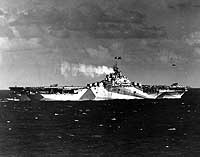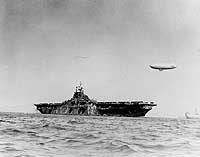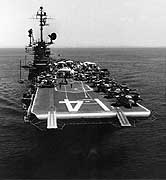
USS Ticonderoga, lead ship of a class of modified 27,100-ton Essex class aircraft carriers, was built at Newport News, Virginia. She was commissioned in May 1944 and made a West Indies shakedown cruise prior to transiting the Panama Canal to the Pacific in early September. During the next few months, Ticonderoga transported aircraft to Hawaii, took part in underway ordnance replenishment experiments and trained her crew and air group for participation in the war against Japan. After steaming to the western Pacific in October, the carrier launched her first strikes on 5 November 1944, hitting targets ashore and afloat in the northern Philippines area. As part of Task Force 38, she continued her attacks in the vicinity for the next two months, riding out a major typhoon in mid-December.
In January 1945, Ticonderoga took part in raids against Japanese assets in Indochina, China, Luzon and Formosa. Hit by two "Kamikaze" suicide planes on 21 January, she lost over 140 crewmen and had to go to the U.S. for repairs. Ticonderoga returned to the combat area in late May. For the remaining two and a half months of the Pacific War, her planes made regular attacks on the Japanese home islands. From September 1945 into January 1946, she transported veterans home across the Pacific. Inactive after that, Ticonderoga was decommissioned at the Puget Sound Navy Yard in January 1947.
Five years later, Ticonderoga was temporarily reactivated and sent to the New York Naval Shipyard to receive an extensive SCB-27C modernization. Redesignated CVA-14, she recommissioned in September 1954 and served with the Atlantic Fleet for two years, making one Mediterranean deployment in 1955-56. More modifications followed in 1956-57, providing an angled flight deck and enclosed bow to fully suit her to operate high-performance jet aircraft. She then returned to the west coast, her home for the rest of her career.
Ticonderoga deployed ten times to the western Pacific in 1957-69. In August 1964, during her sixth WestPac cruise, her planes participated in air strikes against North Vietnamese targets during the "Tonkin Gulf Incident" that gradually led to massive U.S. involvement in Southeast Asian combat operations. Vietnam War missions dominated Ticonderoga's next four Seventh Fleet deployments. In October 1969, she was redesignated CVS-14 and converted to an antisubmarine warfare support carrier. The ship made two more cruises to Asian waters in that capacity. In 1972, she took part in space flight recovery efforts for the Apollo 16 and 17 Moon flights. Decommissioned in September 1973, USS Ticonderoga was sold for scrapping a year later.
This page features selected views of USS Ticonderoga (CV/CVA/CVS-14).
| If you want higher resolution reproductions than the digital images presented here, see: "How to Obtain Photographic Reproductions." |
Click on the small photograph to prompt a larger view of the same image.
|
Photo #: NH 92242 USS Ticonderoga (CV-14) Off San Diego, California, 16 September 1944, loaded with aircraft to be transported to Hawaii. The ship is painted in camouflage Measure 33, Design 10a. Photographed from a blimp of squadron ZP-31. Official U.S. Navy Photograph, from the collections of the Naval Historical Center. Online Image: 102KB; 740 x 595 pixels |
 |
|
Photo #: NH 92243 USS Ticonderoga (CV-14) At sea off the Philippines, just prior to her first strike against the Japanese, 5 November 1944. The ship is painted in camouflage Measure 33, Design 10a. Official U.S. Navy Photograph, from the collections of the Naval Historical Center. Online Image: 90KB; 740 x 605 pixels |
 |
|
Photo #: NH 77366 USS Ticonderoga (CV-14) In San Francisco Bay, California, following the end of World War II, circa late 1945 or early 1946. A blimp is in the background. Courtesy of Donald M. McPherson, 1973. U.S. Naval Historical Center Photograph. Online Image: 77KB; 740 x 605 pixels |
 |
|
Photo #: NH 97487 USS Ticonderoga (CVA-14) Refueling from USS Ashtabula (AO-51), while operating off the coast of Vietnam, circa early 1966. Although seas were running very high, the ships completed replenishment and Ticonderoga received 175,000 gallons of black oil. The original print was received by the "All Hands" magazine Editorial Department on 14 February 1966. Official U.S. Navy Photograph, from the collections of the Naval Historical Center. Online Image: 108KB; 740 x 610 pixels |
 |
|
Photo #: NH 97488-KN (Color) USS Ticonderoga (CVS-14) With her rails manned, circa 1970-72, following conversion to an anti-submarine warfare support aircraft carrier. Official U.S. Navy Photograph, from the collections of the Naval Historical Center. Online Image: 99KB; 740 x 600 pixels |
 |
|
Photo #: USN 1152586 USS Ticonderoga (CVS-14) Underway off San Diego, California, after departing Naval Air Station, North Island, for her final Western Pacific deployment, 17 May 1972. Official U.S. Navy Photograph. Online Image: 91KB; 600 x 675 pixels Reproductions of this image may also be available through the National Archives photographic reproduction system as Photo # 428-N-1152586. |
 |
|
Photo #: 80-G-305244 USS Ticonderoga (CV-14) Grumman F6F "Hellcat" fighters prepare to take off for strikes against targets in Manila Bay. The two leading planes are F6F-5N night fighters, with wing-mounted radar. Photograph is dated 9 January 1945, but may have been taken during the 5-6 November 1944 attacks. Official U.S. Navy Photograph, now in the collections of the National Archives. Online Image: 81KB; 700 x 630 pixels Reproductions of this image may also be available through the National Archives photographic reproduction system. |
 |
|
Photo #: 80-G-469512 USS Ticonderoga (CV-14) Enlisted aircrewmen are briefed in their ready room, 4 November 1944, prior to an air strike on Manila Bay the following morning. Official U.S. Navy Photograph, now in the collections of the National Archives. Online Image: 105KB; 740 x 605 pixels Reproductions of this image may also be available through the National Archives photographic reproduction system. |
 |
|
Photo #: 80-G-273151 USS Ticonderoga (CV-14) Afire after she was hit by a "Kamikaze" attack off Formosa, 21 January 1945. Photographed from USS Miami (CL-89). A Vought OS2U "Kingfisher" floatplane is on the cruiser's starboard catapult, in the foreground. Official U.S. Navy Photograph, now in the collections of the National Archives. Online Image: 86KB; 740 x 610 pixels Reproductions of this image may also be available through the National Archives photographic reproduction system. |
 |
|
Photo #: KN-5442 (Color) USS Ticonderoga (CVA-14) A-4 "Skyhawk" landing on board, after a simulated strike on "enemy" forces during an operational readiness inspection, 18 January 1963. An A-3B "Sky Warrior" and F-3 "Demon" are parked on the carrier's after flight deck, and another A-3 is in the upper left distance, making its landing approach. Official U.S. Navy Photograph. Online Image: 82KB; 740 x 595 pixels Reproductions of this image may also be available through the National Archives photographic reproduction system as Photo # 428-KN-5442 |
 |
|
Photo #: USN 1149754 Three S-2E "Tracker" aircraft, of Antisubmarine Squadron 33 (VS-33) Fly past USS Ticonderoga (CVS-14), off San Diego, California, circa late 1971. At that time VS-33 had completed eleven years of accident-free flying. Photo was received by the Naval Photographic Center in November 1971. Official U.S. Navy Photograph. Online Image: 135KB; 740 x 615 pixels Reproductions of this image may also be available through the National Archives photographic reproduction system as Photo # 428-N-1149754. |
 |
| If you want higher resolution reproductions than the digital images presented here, see: "How to Obtain Photographic Reproductions." |
Page made 27 January 2001
Link added 12 January 2003